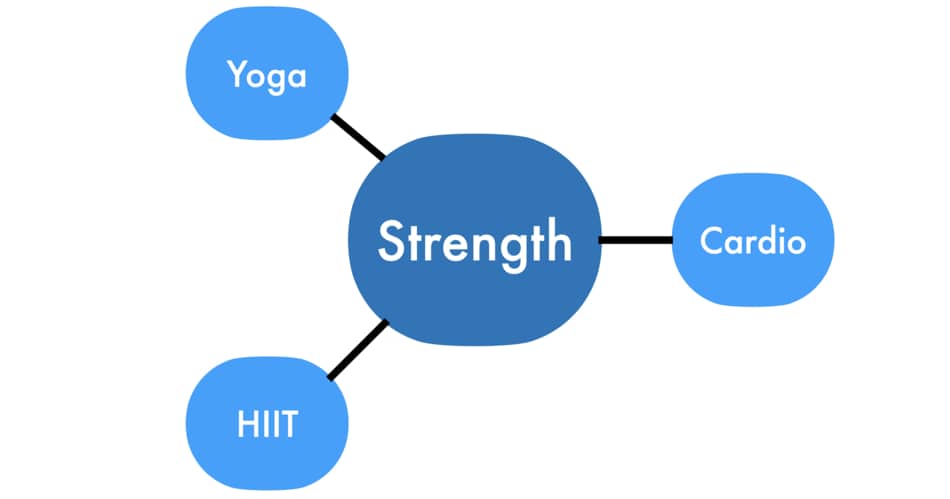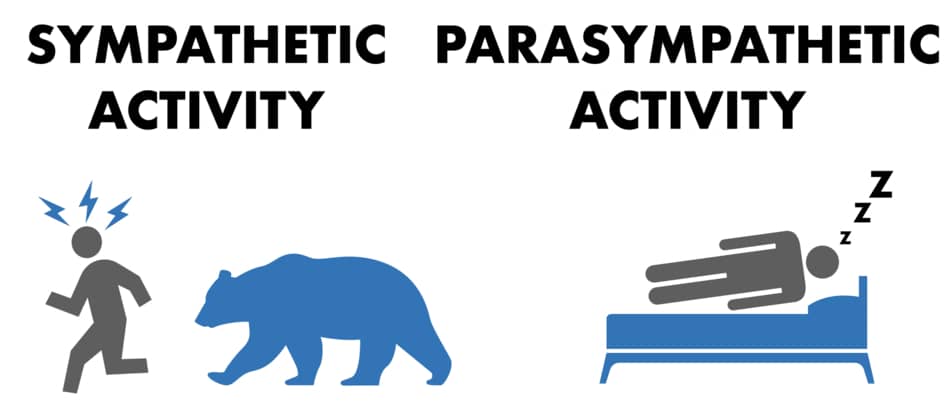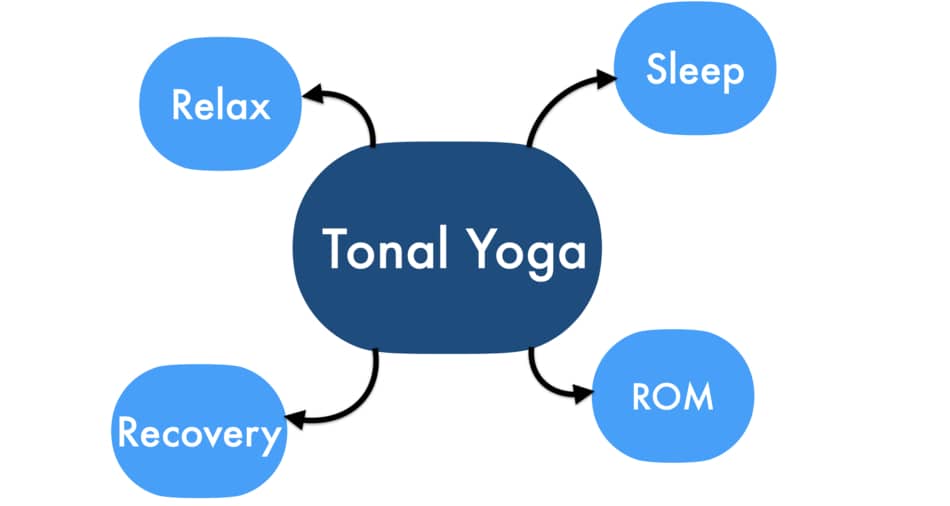Today I will explain everything there is to know about Tonal yoga (plus why I recommend you should do it more often).
As a whole, Tonal has over 120 yoga workouts that range from 4 to 63 minutes. They include classes like Yoga Flex Flow where you cover the whole body, moving from one pose to another, as well as single asana tutorials like Forearm Stand or Sun Salutation where you only practice one move in the class.
I will also touch on why I decided to focus more on Tonal yoga, instead of HIIT or other cardio workouts, especially when traveling.

What Is Tonal Yoga?
I’ve been a huge fan of Tonal gym cable training not only because it allowed me to train in the comfort of my home, but also it has several smart features that transform your workouts into personal training sessions.
However, in the last couple of years, the company added a large selection of classes that you can use without the equipment (like pilates, kickboxing, or yoga).
What is Tonal yoga? In general, Tonal yoga is a collection of yoga on-the-go classes with different styles of yoga (flow, ashtanga, vinyasa) that are available with the Tonal membership.
The classes are split into full-body workouts, specific body parts (e.g. lower body, core, upper body) that cover certain muscle groups, and short sessions called “Yoga Studio” that help to improve one particular pose like Warrior Pose.
In other words, you can use Tonal yoga not only as an alternative to your regular strength workouts but also as a recovery tool to reduce tension in specific muscle groups.
For example, Lower Body Stretch with coach Frances is a 34-minute session where she focuses on hamstring flexibility, which is great for people who spend most of the day behind the desk. This means you can save time and work only on the “areas of concern” instead of doing a full 60-minute yoga routine.
Another example is the Vinyasa For Hip Mobility with coach Nikki. This workout targets hip flexibility and can help you improve your everyday posture which will translate to better walking, jumping, running, squatting, lunging, or hip hinging.
NOTE: Click here to learn more about what are the best “tonal workouts” for fat loss and muscle mass.
How Does Tonal Yoga Work?
Overall, Tonal yoga works mainly as an addition to the regular strength training workouts that you do with Tonal. It can be used as a way to reduce muscle stiffness before training, enhance recovery, and post-workout mobility, or as a part of the relaxation and meditation practice.
See the graph below.

As you can see, Tonal yoga should not be used as the main exercise you do, but rather as a complement to resistance training together with other classes.
Is Tonal yoga hard? Overall, most of the Tonal yoga classes are not hard because most of the workouts are designed to either prepare you for the strength training class (e.g. open the hips to increase range of motion) or to reduce muscle tension after the workout.
For example, Post Lift Yoga Flow helps to release muscle tension and brings the body back into balance after lifting.
In other words, this class is not designed to make you an ultra-flexible yogi where you can do handstands. It is more of mobility, relaxation, and de-stress tool.
Is Tonal yoga good for beginners? In general, Tonal yoga is good for beginners because it includes gentle poses that don’t require an advanced level of flexibility. However, some of the short classes like Flying Pigeon Pose last only 4 minutes but can be hard on the shoulders, arms, and core.
Is Tonal Yoga Effective?
As a whole, Tonal yoga is effective because it not only helps to reduce DOMS (delayed onset muscle soreness) but also allows to upregulate the autonomic nervous system by activating parasympathetic response and decreasing sympathetic activity.
What is the autonomic nervous system? In short, the autonomic nervous system regulates processes like heart rate, blood pressure, breathing, digestion, and sexual arousal. It works by a balance between the sympathetic and parasympathetic nervous systems.
See below.

As you can see, the sympathetic nervous system (SNS) is also called the “fight or flight” response and it activates during stressful situations. The parasympathetic nervous system (PNS) is called “rest and digest” and it kicks in during relaxation time.
Tonal yoga can help to balance the two
Tonal yoga can help to balance the two by activating the relaxation response, decreasing allostatic load, and reducing the accumulation of physical and psychological stress on the body.
Studies have shown that “yoga stretching can enhance parasympathetic nerve activity and improve stress hormones. Therefore, yoga stretching may be useful to compensate for physical inactivity and increase life expectancy in the general population” (Eda et al. 2020).
That is also the reason why I use Tonal yoga more often than HIIT classes when traveling. I find that doing HIIT and Tabata workouts often makes me more tired when I’m on the road, whereas Tonal yoga helps me to stay calm and relaxed.
In fact, Dr. Cho, Sang-Hee from the Kyung Nam University in South Korea has documented that “there is a correlation between the level of travel stress and the other variables such as travel destination, tourist value, and types of travel. Especially, tourist value and types of travel significantly affect travel stress” (source).
This means traveling (especially overseas) can create a lot of stress on the body and doing activities like yoga helps to down-regulate the sympathetic nervous system and relax the body.
Can Tonal yoga help you lose weight?
Overall, Tonal yoga can help you lose weight because reducing stress leads to less emotional eating, which is one of the main reasons for weight gain. This means that a prolonged stressful environment can lead to eating more food.
Not only that.
Studies have shown that people not only eat more but also choose more pleasurable and palatable foods during times of stress (typically favor those of high fat and/or sugar content) (Yau, 2013).
Doing Tonal yoga on the weekly basis helps to regulate stress-related adaptive processes (aka fewer food cravings).
Can Tonal yoga build muscle? In general, Tonal yoga can build muscle, as long as the classes are hard enough to reach muscle failure. However, I would not recommend using Tonal yoga for hypertrophy purposes, but rather to reduce SNS and improve PNS activity.
How To Use Tonal and Yoga
In general, you can use Tonal yoga as a tool to improve movement inefficiencies to restore optimal range of motion by either stretching before or after the strength training sessions. You can also use it to reduce muscle and/or joint pain, as well as to enhance the recovery process.

Tonal Yoga For Recovery
As a whole, Tonal yoga is good for active recovery because it helps to clear movement restrictions, which will transfer into a better position during strength training exercises.
For example, if you feel that after your workout you cannot touch your toes from a standing position, this is a clear indicator of hamstring and lower back restriction, which can influence the form of your next squat and deadlift session.
Learn more: Click here to learn more about what is more effective, “walking vs yoga“.
What is active recovery? Active recovery is a low-intensity movement (e.g walking) that is done either after the main exercise (e.g. stretching after a strength session) or separately on the days off. The goal of active recovery is to increase circulation and reduce blood lactate concentration.
Tonal has many short classes (e.g. 11 minutes stretch) that can be done immediately after a weight lifting workout to speed up the recovery process, as well as longer classes that can be done on rest days.
NOTE: Click here to learn more about how to create a “tonal leg workout” to speed up your recovery.
Tonal Yoga For Improved Range Of Motion
Another benefit of using Tonal yoga is a better range of motion.
Urban living, daily commuting, less-than-optimal sleep, working under stress, and staying in one position for a long time (e.g. sitting) can create biomechanical restrictions which limit the range of motion in the joints.
Also, resistance training itself can lead to exercise-induced muscle fatigue, reversible loss of muscle force, muscle tension, and soreness. This, of course, results in a gradual decrease in muscle contraction power.
In other words, feeling sore after a workout not only feels “uncomfortably painful” but also impairs your training performance. This can last for a few minutes, hours, or days, depending on the level of fitness.
Using Tonal yoga is a good way to improve your range of motion and reduce muscle and joint pain.
Learn more: Click here to learn more if you should be doing “yoga before or after workout“.
Tonal Yoga For Sleep
Overall, Tonal yoga is good for sleep because it has many classes with gentle yoga poses that help to relax the body and calm the mind. Some of the classes also include meditation practices like pranayama, mantra, and locking of bandhas.
Studies have shown that “yoga practice significantly improves a range of subjective factors, including overall sleep quality; sleep efficiency; sleep latency and duration; self-assessed sleep quality; fatigue; general well-being; depression; anxiety; stress; tension; anger; vitality; and function in physical, emotional, and social roles” (Halpern et al. 2014).
Tonal Yoga Classes
Overall, Tonal has many yoga classes that range from beginners to advanced. Easier classes are designed to either reduce stress or alleviate muscle soreness, whereas the intermediate and advanced workouts are designed to push your body to the limit via harder yoga postures.
Here are some of the main types of Tonal yoga classes.
| Tonal class | Description |
|---|---|
| Yoga Studio | Tonal Yoga Studio are short classes that focus on practicing one specific movement |
| Flow | Tonal yoga flow is a class where you follow the yoga routine inspired by vinyasa flow |
| After class | These classes are mainly focused on reducing tension in the muscles after resistance training. |
| Before class | Tonal yoga before lifts helps to increase mobility and get you ready for a challenging session. |
| Prenatal Yoga | Tonal prenatal yoga is a selection of specific yoga poses that can be done during pregnancy. |
One thing I don’t like about Tonal yoga is it’s only available in their on-the-go library, which means there are no live yoga classes. However, you can stream them from any device (especially when traveling) which I like.
You can learn more about other “tonal live classes” in my article here.
How Often Should You Do Tonal Yoga?
How often you should do Tonal yoga will depend on your fitness goals, the amount of time you have for training, and your flexibility. People who have more free time and want to improve their mobility can include one short yoga workout every other day and one to two longer classes per week.
I like to do 4-5 Tonal strength training sessions, followed by 3-2 Peloton rides, and usually 1 Tonal yoga workout per week. However, I also do a lot of walking, play tennis, swim, and run outdoors (when weather permits).
Also, I like to add a short Tonal yoga class after each strength class (when I have time).
Can you do Tonal yoga every day? Overall, you can do Tonal yoga every day, as long as you choose short classes that include gentle stretches like 21 minutes Wake Up With Yoga class first thing in the morning.
Also, you can use classes that are focused on one specific body part like an 18-minute Hip And Leg Recovery Flow to reduce muscle stiffness after a hard leg day.
Here is the table with the example of how often to use Tonal yoga.
| Days | Tonal yoga class |
|---|---|
| Monday | Sun Salutation A (morning before work) |
| Tuesday | Upper Body Recovery Flow (after upper body lifts) |
| Wednesday | Backbend Bliss (after work on recovery day) |
| Thursday | Lower Body Bliss (after lower body lifts) |
| Friday | Morning Ritual (morning before workout) |
| Saturday | Unwind And Chill (the evening before bed) |
| Sunday | Full Body Recovery Flow (recovery day) |
Tonal Yoga Instructors
In general, Tonal does have 4 instructors that specialize in yoga and meditation classes. Each of the trainers is qualified, experienced, and passionate about mindful movement, which is transparent in the way they teach their classes.
- Coach Frances – Frances is one of the most popular Tonal yoga coaches with over 40 classes behind her belt. She specializes in balance, pilates, yoga, and strength workouts.
- Coach Jake – Coach Jake is a personal trainer, yoga teacher, and meditation specialist. His classes mainly focus on strength and power. He teaches over 30 yoga and meditation classes on Tonal. He is the toughest yoga coach of all Tonal trainers.
- Coach Nikki – Coach Nikki specializes in yoga and mobility workouts. She teaches over 20 different yoga classes that range in all styles of yoga.
- Coach Brett – Coach Brett is new to the Tonal family with just over 10 yoga classes in the library. He specializes in martial arts, functional training, and yoga practice.
Conclusion
As you can see, Tonal yoga is a great tool to reduce muscle tension because it speeds up the lactate removal from the muscles during and after exercise, which helps with lowering DOMS that happens after weight lifting.
It also can be used as a regular full class on your days off, as a part of the active recovery.
